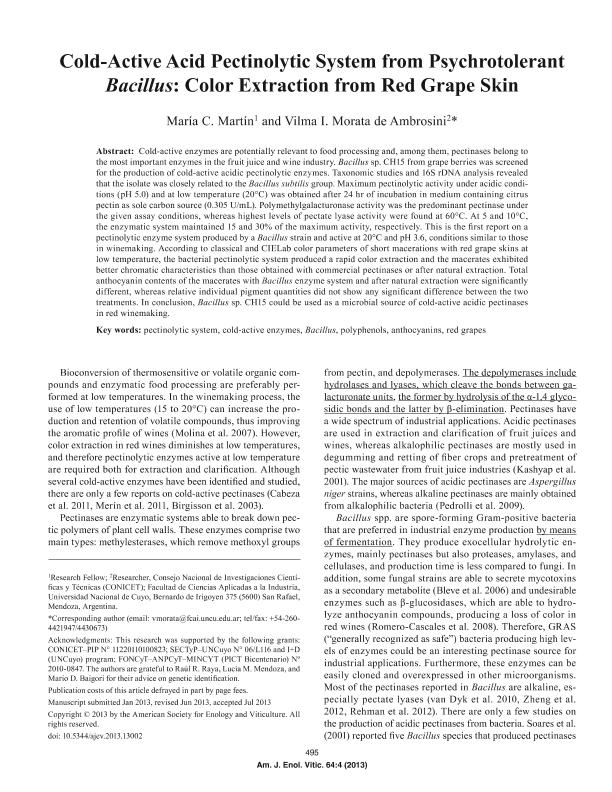Mostrar el registro sencillo del ítem
dc.contributor.author
Martín, María Carolina

dc.contributor.author
Morata, Vilma Ines

dc.date.available
2016-08-31T17:10:08Z
dc.date.issued
2013-12
dc.identifier.citation
Martín, María Carolina; Morata, Vilma Ines; Cold-active acid pectinolytic system from psychrotolerant Bacillus: Color extraction from red grape skin; American Society for Enology and Viticulture; American Journal for Enology and Viticulture; 64; 4; 12-2013; 495-504
dc.identifier.issn
0002-9254
dc.identifier.uri
http://hdl.handle.net/11336/7362
dc.description.abstract
Cold-active enzymes are potentially relevant to food processing and, among them, pectinases belong to the most important enzymes in the fruit juice and wine industry. Bacillus sp. CH15 from grape berries was screened for the production of cold-active acidic pectinolytic enzymes. Taxonomic studies and 16S rDNA analysis revealed that the isolate was closely related to the Bacillus subtilis group. Maximum pectinolytic activity under acidic conditions (pH 5.0) and at low temperature (20°C) was obtained after 24 hr of incubation in medium containing citrus pectin as sole carbon source (0.305 U/mL). Polymethylgalacturonase activity was the predominant pectinase under the given assay conditions, whereas highest levels of pectate lyase activity were found at 60°C. At 5 and 10°C, the enzymatic system maintained 15 and 30% of the maximum activity, respectively. This is the first report on a pectinolytic enzyme system produced by a Bacillus strain and active at 20°C and pH 3.6, conditions similar to those in winemaking. According to classical and CIELab color parameters of short macerations with red grape skins at low temperature, the bacterial pectinolytic system produced a rapid color extraction and the macerates exhibited better chromatic characteristics than those obtained with commercial pectinases or after natural extraction. Total anthocyanin contents of the macerates with Bacillus enzyme system and after natural extraction were significantly different, whereas relative individual pigment quantities did not show any significant difference between the two treatments. In conclusion, Bacillus sp. CH15 could be used as a microbial source of cold-active acidic pectinases in red winemaking.
dc.format
application/pdf
dc.language.iso
eng
dc.publisher
American Society for Enology and Viticulture
dc.rights
info:eu-repo/semantics/openAccess
dc.rights.uri
https://creativecommons.org/licenses/by-nc-sa/2.5/ar/
dc.subject
Pectinolytic System
dc.subject
Cold-Active Enzimes
dc.subject
Polyphenols
dc.subject
Anthocyanins
dc.subject
Bacillus
dc.subject
Red Grapes
dc.subject.classification
Bioprocesamiento Tecnológico, Biocatálisis, Fermentación

dc.subject.classification
Biotecnología Industrial

dc.subject.classification
INGENIERÍAS Y TECNOLOGÍAS

dc.title
Cold-active acid pectinolytic system from psychrotolerant Bacillus: Color extraction from red grape skin
dc.type
info:eu-repo/semantics/article
dc.type
info:ar-repo/semantics/artículo
dc.type
info:eu-repo/semantics/publishedVersion
dc.date.updated
2015-10-15T19:54:39Z
dc.journal.volume
64
dc.journal.number
4
dc.journal.pagination
495-504
dc.journal.pais
Estados Unidos

dc.journal.ciudad
Davis
dc.description.fil
Fil: Martín, María Carolina. Universidad Nacional de Cuyo. Facultad de Ciencias Aplicadas A la Industria. Departamento de Bromatologia - Alimentacion. Area Biologia; Argentina
dc.description.fil
Fil: Morata, Vilma Ines. Universidad Nacional de Cuyo. Facultad de Ciencias Aplicadas A la Industria. Departamento de Bromatologia - Alimentacion. Area Biologia; Argentina. Consejo Nacional de Investigaciones Científicas y Técnicas. Centro Científico Tecnológico Mendoza; Argentina
dc.journal.title
American Journal for Enology and Viticulture
dc.relation.alternativeid
info:eu-repo/semantics/altIdentifier/url/http://www.ajevonline.org/content/64/4/495
Archivos asociados
